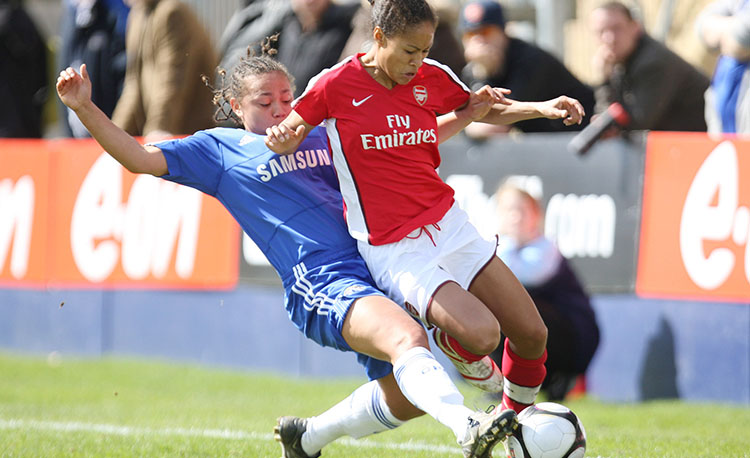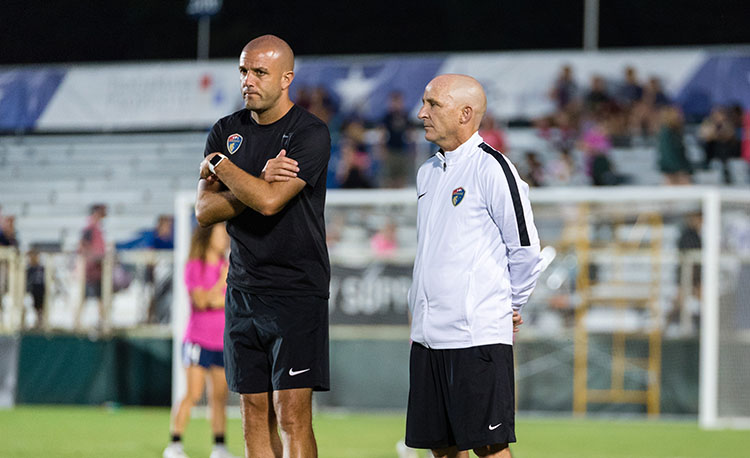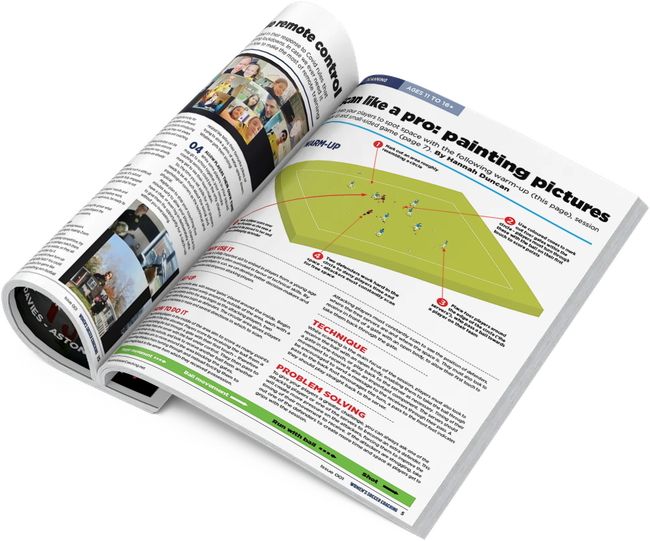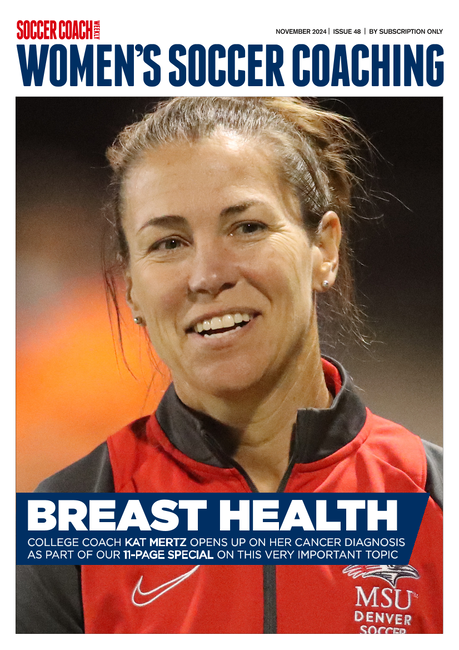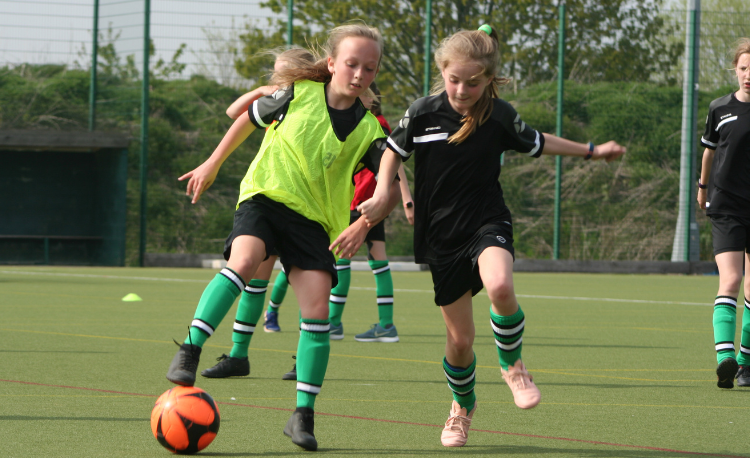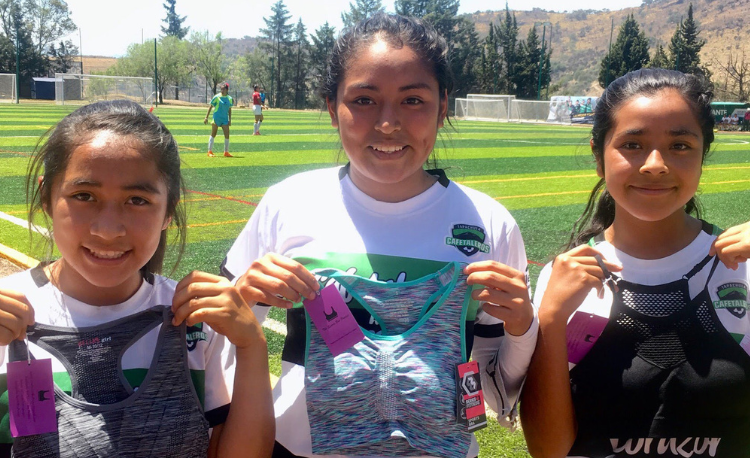You are viewing
1 of your 3 free articles
How to prepare girls for senior football
Coaching Adviceby Sean Nahas
North Carolina Courage academy director Sean Nahas and Oxford United Under-16s coach Ellen Hopkins on readying youngsters for adult soccer
For most of our players, the pathway is to collegiate programs, where they can continue their education and playing careers.
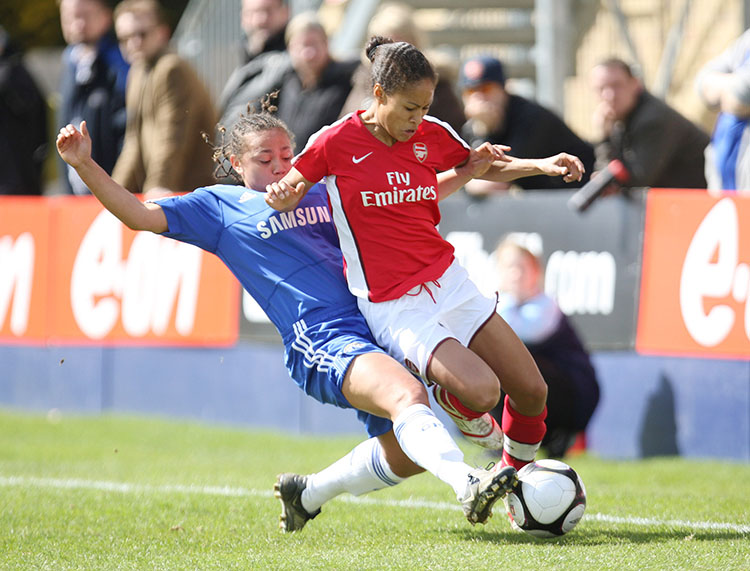
Drew Spence (left), then a rookie at 17 but now a Chelsea first-team player, learned quickly at senior level. Here, she tackles Arsenal legend Rachel Yankey back in 2009.
From there, some may determine the pro level is for them and some will decide to follow their journey in the major they received their diplomas for. Either way, we couldn’t be more proud of our players.
From a physical development standpoint, I feel the biggest difference is the maturity of the players. Senior players are able to manage their bodies a lot easier than a youth player, mainly due to what they have access to in terms of recovery and time off during the day.
For youth players it is non-stop. They wake up very early, go to school for seven or eight hours, then head straight to training for 75-90 minutes. Some travel in a car for 30 minutes to as long as an hour and 45 minutes each way. The physical demands can be very hard on these young players, and proper nutrition and hydrating can be negatively impacted.
However, every day they are at training with a smile on their face ready to be better than the day before. What these young players are able to accomplish is special and I am in awe of them all.
Within our programming, we put a very heavy emphasis on technical proficiency. For the style we want to play - a creative, possession-based style - the technical quality of our players is very important.
Alongside that, we not only want to teach the game, we want them to understand the game. We start teaching the principles of our program from the day they step into our academy. We want all of our players to play the same way and the roles and responsibilities of each position to be similar. Why? Because it allows for easier transition through the programming and through our staff.
Over the past four to five years, we have had approximately 15 players training with our first team. Keeping in mind they will not play at the same speed as our first team, their individual quality on the ball is important for them to have some success in the first-team setting.
For them, it is more about the learning experience than anything else. We want them to learn from the differences they may be faced with within the first-team environment. As time passes, they do become acclimatized a bit more, but in the end the speed of play will always be the difference.
Our young players have to deal with so many exterior factors right now - Covid-19, school, exams, life in general - and all of that plays a major part in their training habits and quality.
Because they are in school all day there are moments where energy within training may not be where we need it to be. So, as a staff, it is important for us to monitor our players daily.
We provide GPS units for training to see how their numbers are doing and we provide readiness reports to see the daily mode and feeling of each player so we know how to manage them each day. We try to keep it as professional and treat them as professional as we possibly can.
For me, I think what is so important in transitioning to first-team soccer is the approach. What is the emphasis that is talked about or made in their respective programs?
For us, we don’t emphasize results with our teams (even our first team). Our emphasis is on the performance. We want our performances to be what stands out and not just what the score is at the final whistle.
It’s critical for staff to create the necessary environment for their players’ development. Always stay true to what you believe in and stick to it, through the good and bad. Create pictures for your players within your session design that will help them to recognize what they may see each game. Help your players to fall in love with the game.
I am a firm believer in ‘train the way you want to play’. I always equate what we do to school. Kids in first grade don’t jump straight to graduating. Each year, we layer ideas and information for them to grow with, for them to develop.
That is what is most important. Help them to grow and chase their dreams. But it is a step by step process, it isn’t a straight line progress. Our job is to help provide the foundation for our players to dare to dream.
3 TOP TIPS ON PREPARING YOUTH PLAYERS FOR SENIOR SOCCER - BY Sean Nahas
Related Files
WSC-005-how-to-prepare-girls-for-senior-football.pdfPDF, 868 KB
DETAIL: Providing the necessary detail for players to perform is so important. The detail in the ‘why?’ and ‘how?’ of what we are asking them to do is too often lacking.
DEVELOPMENT: Stay true to what you believe in. What is the desired outcome? Is it a result or is it a performance? For us, the performance is the most important thing.
Focus on what you worked on in that week of training, and in the games focus on the performance in those areas. How was it? From there, you can then look back at what was taught and how. It’ll allow you to reflect on any changes that need to be made.
STANDARDS: It’s important for players to feel a sense of standards (note: not rules) within their programming. Standards allow the players to meet a certain level and apply the accountability needed to attain them. As coaches, help to create a high level and maintain standards in the detail and their development. That makes the players want to come back each day and be better. As we say in our program, “be the standard”.
Ellen Hopkins
Oxford United U16s assistant coach. Ellen holds a UEFA B license and FA Youth Module 3, and boasts more than 11 years’ experience coaching youth and adult football. She spent two years coaching in the US and now works as a County FA Football Development Officer, leading on women’s, girls’ and recreational football.
Having made my own senior debut at the age of 16, I have had first-hand experience of making the transition into adult football and understand the challenges it brings.
Players develop at different speeds physically, technically and psychologically. As a coach it’s important you cover all of these bases to support the transition process.
At Oxford United Under-16s, we look to support players individually and as a collective to become first-team players.
In 2020, the club launched a Women’s Development Squad, to try to bridge the gap between the first team [in English football’s third tier] and the RTC [Regional Talent Club, as some academies in England are known].
It acts as a stepping stone for those players who may need to develop further after leaving the RTC, while offering them time and a competitive environment to do so.
In the U16s, a lot of time was spent aligning specific positional roles and responsibilities in various phases of the game (in possession, out of possession, transition, etc). These mirror what is expected within the first team, meaning it should come as second nature to those players who do make the transition.
Not only do we focus on these roles technically on the field, but also within weekly workshops, as it is also important for the girls to understand the tactical side of the game.
We are lucky to have a close working relationship with first-team manager Liam Gilbert, who supports us with this process.
In terms of positional understanding, we give each player both a primary position and a related secondary one. For example, a player who is primarily a central defender may have central midfield as their secondary position.
The idea is that, while some principles of the two positions are the same, it also encourages them to adapt and develop the technical detail needed to play the secondary position.
A centre-back, for example, may become confident playing passes through the units with her experience of playing in central midfield. This adaptability is really important in the modern game, as roles may be slightly different depending on the formation. For example, a centre-back in a 4-3-3 has different responsibilities than in a 3-5-2.
By challenging them at a young age, within the RTC, they already have that experience of being versatile when making the step up to senior football.
As coaches, we must adapt our coaching and suit it to the players in front of us and their needs. It’s never a one size fits all. It’s also important to add they are still youth players and when they make the step up it’s going to take them time to adapt and settle into the senior environment.
Newsletter Sign Up
Newsletter Sign Up
Discover the simple way to become a more effective, more successful soccer coach
In a recent survey 89% of subscribers said Women's Soccer Coaching makes them more confident, 91% said Women's Soccer Coaching makes them a more effective coach and 93% said Women's Soccer Coaching makes them more inspired.
*includes 3 coaching manuals
Get Inspired
All the latest techniques and approaches
Women's Soccer Coaching offers proven and easy to use soccer drills, coaching sessions, practice plans, small-sided games, warm-ups, training tips and advice.
We've been at the cutting edge of soccer coaching since we launched Soccer Coach Weekly in 2007, creating resources for the grassroots youth coach, following best practice from around the world and insights from the professional game.
